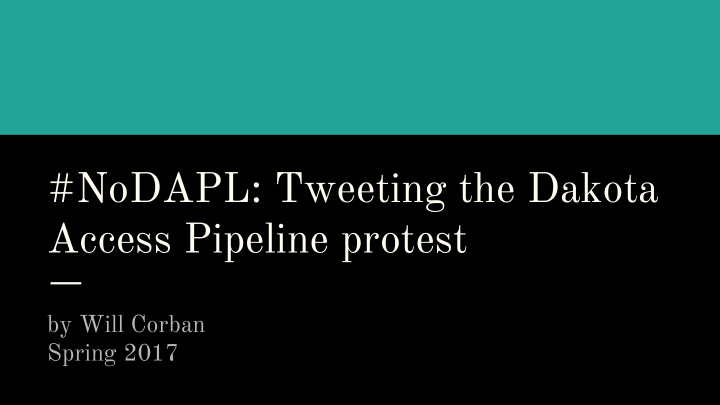



#NoDAPL: Tweeting the Dakota Access Pipeline protest by Will Corban Spring 2017
Background ● The planned Dakota Access Pipeline would carry shale oil from northern North Dakota to Illinois ● The pipeline’s route runs through land belonging to indigenous people ● Protesters camped at Standing Rock from April 2016 to February 22, 2017 when they were forcibly removed ● Protests involved indigenous rights, environmental issues, and Photo by Marlene Tsosie Bad Warrior. From http://blogs.jccc.edu/campusledger/2016/10/07/pipeline-protests-at-standing-rock-continue/ energy use
Word Cloud
Word Cloud ● Organizes the Twitter conversation ● Reveals core concerns of participants ● Connects #NoDAPL to related issues ● Highlights primary focus on indigenous rights
Social Network Analysis
Social Network Analysis ● Shows popular and influential users ● Creates groups based on Twitter conversations ● Connects retweets and mentions with their “owners”
Social Network Analysis
Theory The Filter Bubble A New Algorithmic Identity Eli Pariser John Cheney-Lippold ● Separates groups online based on beliefs ● Sorts internet users based on habits ● Creates self-curated “echo chamber” that ● Produces new results from prior mirrors one’s own ideas searches/interactions ● Blocks out opposing views and alternate ● Dictates how the internet and search perspectives engines present information ● Reduces diversity of online community and stifles discussion
Works Cited Cheney-Lippold, John. “A New Algorithmic Identity: Soft Biopolitics and the Modulation of Control.” Theory, Culture & Society 28, no. 6 (2011) : 164-181. “Dakota Pipeline: What’s behind the controversy?,” US & Canada, BBC News , accessed April 29, 2017, http://www.bbc.com/news/world-us-canada-37863955 Pariser, Eli. “Beware of online ‘filter bubbles.’” Presentation at Ted2011: Invention and Consequence, Long Beach, CA, March 3, 2011.
Recommend
More recommend